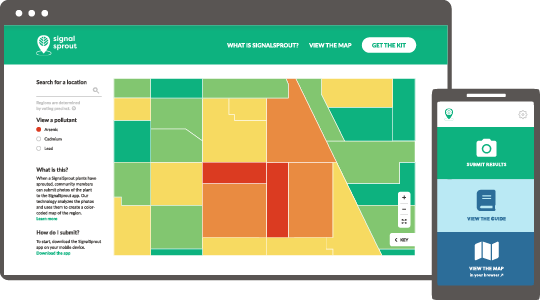The concept that science can and should be accessible to all is the grounding principle behind the Science Communication Lab at the University of Minnesota. Founded to provide interdisciplinary internship opportunities, the lab has consistently attracted College of Design undergraduate students interested in creating stories or media that make complex research and scientific topics accessible to the general public.

Photo by Mikaela Armstrong (BFA '19, Graphic Design) of student interns at work in the Science Communication Lab. Clockwise from the left: Jenna Privatsky (BFA '18, Graphic Design), Holly McKee (Writing Intern), Katie Sabbia (Writing Intern), Megan Smith (BFA '19, Graphic Design), Shannon Allen (Writing Intern), Jingru Chen (BFA '18, Graphic Design).
What may at first seem like an unlikely pairing, the relationship between designers and scientists is quite complementary, according to Michael Winikoff, Director of the Science Communication Lab.
“Design students are critical to our work,” stated Winikoff. “People often expect designers to simply ‘make things look pretty,’ but all our students engage with complex issues and solve problems. Designers often ask questions scientists don't think to ask. They help us simplify messaging, communicate more clearly, and develop creative strategies for delivering content to the public. Without the designers, the Science Communication Lab wouldn't exist,” he explained.
Born from Winikoff’s programming at the Biotechnology Institute, The Science Communication Lab works with museums and departments across the University to share stories about their research and scientific discovery. Much of the lab’s recent work has centered on equity and diversity in an effort to include new audiences and partners in the conversation around science and academic research. Student interns in the lab represent a wide variety of disciplines and collaborate on teams, gaining exposure to new material, access to experts, time to experiment, and feedback in the form of group critiques. Projects span the sciences and humanities with outcomes ranging from research profiles to infographics, curriculum materials, and animated videos.
Rose Lam (Graphic Design) discovered the lab while looking for student jobs. The position stood out as a unique opportunity to work with peers outside of the graphic design program on projects with a technical communication focus. Lam has now participated on several teams to create a dynamic webpage explaining anaerobic digestion, an animated COVID-19 video series, and a Biodesign Challenge project called SignalSprout, which imagines the role of plants in alerting community members of soil pollution.
“Good science communication is so important, especially now that scientific information (accurate or inaccurate) can spread like wildfire. It’s all about balancing nuance with accessibility, and I think designers have a lot to offer in this respect. It's much easier for us to think from the audience's perspective,” said Lam.
But offering perspective and applying design-thinking principles is just the beginning of what it means to participate in the lab.
Alvina Salim (Product Design), who also worked on the COVID-19 videos and Biodesign Challenge, has been able to expand her skill set beyond traditional product design curricula. “I have learned new tools and Adobe software such as Illustrator, InDesign, and After Effects to create illustrations and animations, which in turn hones my data visualization skills,” expressed Salim.
One recent graduate, Emma Delisi (BFA ’20, Graphic Design), remarked that her time spent collaborating on projects provided benefits beyond academia. “Working with different people (especially non-designers) is a way to make yourself a better designer and set yourself apart.” The work Delisi did in the lab underscored how important empathy can be when figuring out how to express complicated ideas. “Working in the lab made me realize that my main goal as a designer is to make other people's lives easier and better,” concluded Delisi, who is now putting those skills to work as a graphic designer for a software consultancy.
Breaking out of a narrow disciplinary perspective and blending design and science at the outset of a project also impacts outcomes. “Across the board, students can envision and then implement solutions that they couldn't have imagined on their own. One area of growth for the Lab, in collaboration with Assistant Professor Cecilia Wang (Graphic Design), is to explore opportunities and best practices for incorporating design perspectives into the core science curriculum,” said Winikoff.
Whether forging connections across disciplines, building a new skill set, or setting yourself apart in job interviews, students can count on their work in the Science Communication Lab to enrich their undergraduate experience—all while bringing clarity and visibility to critical issues.
Interested in joining the Science Communication Lab team? The lab is looking to hire undergraduate design students of all disciplines for spring semester. Learn more about Science Communication Lab internships and how to apply.
Innovation starts with new challenges and fresh perspectives, a concept well known to both the Product Design program and Andersen Corporation. This notion formed the basis of their spring 2021 collaboration when graduating product design seniors worked directly with Andersen Windows and Doors products and professionals to develop solutions for “bringing the outdoors in” as part of their capstone projects.
Meet people from different backgrounds and use conversation to co-imagine our post-pandemic future in the spring 2021 Design in a Post-Pandemic World Discussion Series.
A collaboration between student-group AIAS Freedom by Design and the non-profit Settled has led to a brand new storage shed for the future Settled community at Mosaic Christian Community Church.






